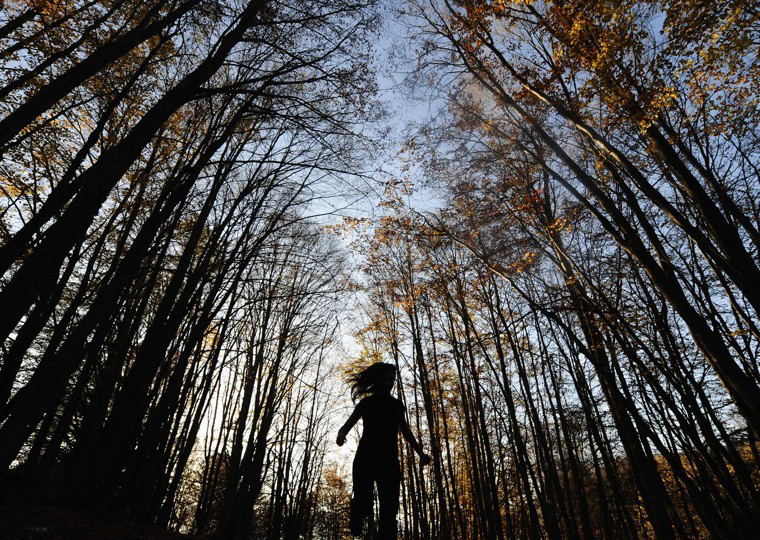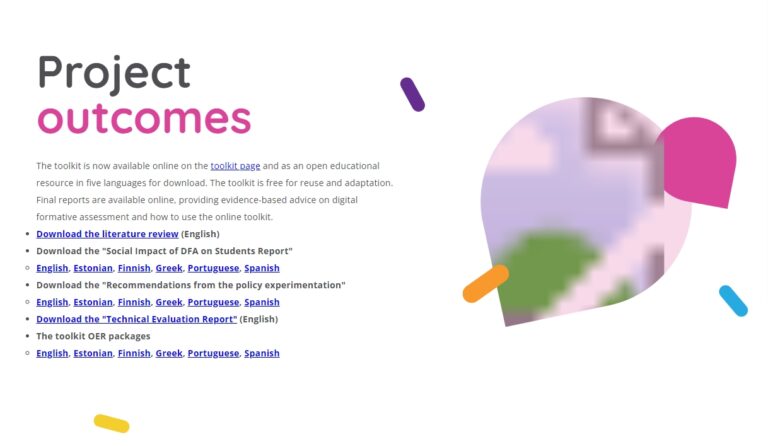Pine needles and crackling fires replace whiteboards and desks in Finland’s forest classrooms.
By: Timothy D. Walker, The Atlantic Sep 15, 2016
“To the brook! To the brook!” the three girls chanted in Finnish as they skipped through the forest. Within a few minutes, the other kindergartners had joined them in the fern-covered gully. As their teacher Kaija Pelo and I stood on a hill observing the children at play below us, two boys in baseball caps poked sticks into the brook (Pelo said they were “fishing”) while other children teetered across a fallen pine tree, which served as a natural bridge over the running water. Most kindergartners, though, appeared to be doing nothing except wandering along the length of the brook.
For these 5- and 6-year-olds, this forest is their kindergarten classroom—nearly 80 percent of the time.
Four days a week, from 8:30 a.m. to 12:30 p.m. (Finland’s required amount of daily kindergarten instruction), this group of 14 children is outside with their veteran teacher and two classroom aides. In Finland, this is not a typical kindergarten setting (only a handful of forest kindergartens exist in this Nordic country), but in Europe, such places have been popular for decades.
“Come on, Timmy!” called Eeni, a tiny girl, who waved me to follow her and her two friends down into the gully. These children had climbed up just to invite me on a tour of their classroom. I followed them. After leaping over the brook, the three girls led me to the uprooted end of the fallen pine tree, where a geocache container—a rare sign of civilization in this section of the woods—had been stored below it. Afterward, we hiked up a hill, keeping the brook as our line, until we reached a (relatively) flat area where small pools had formed. I imagined that these three children could have stayed there for at least an hour, constructing and deconstructing dams, but they were eager to show me the next stop on the tour: a large ditch. Their teacher, who was following me, led the children in counting as they all jumped into the hole in the ground. “One, two, three, four!” they counted in Finnish. (For good measure, I jumped into the ditch, too.) The teacher, Pelo, explained that this experience represented how she and the two aides aspire to teach the kindergartners in the woods. She described this approach as “secret” learning, when children are unaware that they’re learning academic content. In the forest, these Finnish educators might lead the children to find sticks of varying lengths and organize them from shortest to longest, form letters out of natural materials, or count mushrooms. This publically funded forest kindergarten launched several weeks ago, so regular routines are still being developed, but I was curious to hear about its daily schedule. Pelo told me that it largely depends on the day, because they provide the children with a lot of leeway to pursue their own interests, which means that they hold their own teaching plans loosely. Typically, the children have two hours of daily free play in the woods. They set aside time for lunch. Even though the children lack access to toys and electronics, they’ve never reported that they’re bored in the forest, according to Pelo. “But when the winter comes,” she said, “we’ll see.” (Like other forest kindergartens in Europe, this group plans to meet outside rain or shine, even when the temperature plummets.) Throughout my visit, I kept searching for the “bored student,” and after one hour, I thought I finally found him. Reclining against the base of a tree, I spotted a tall blonde boy with a glazed look in his eyes. He simply stared at the brook, listening to its constant gurgling. Then after a few minutes, he pulled himself up and crossed to the other side of the water. The boy wasn’t bored, I corrected myself. He was simply resting. One of the most predictable parts of this kindergarten’s day is the morning ritual they perform, after hiking about a hundred yards from Western Puijo Preschool in the city of Kuopio. Once the children lay their matching, crimson-colored backpacks around the trunk of a pine tree, the class forms a circle and students greet each other by chanting, syllable by syllable, each person’s name—“Ju-ho! Lau-ri! I-lo-na!” Then Pelo reviews the days of the week with a fun song (there’s a different movement for each day), and asks the children to determine the correct date. It was a routine I’d expect to find, in some form or other, in typical kindergarten classrooms in Finland and the United States. But witnessing that morning ritual, in the context of the forest, got me to wonder: Is there something about being outside that’s especially beneficial for kids? “The research strongly suggests that time in nature can help many children learn to build confidence in themselves; reduce the symptoms of Attention Deficit Hyperactivity Disorder, calm children, and help them focus,” Richard Louv, the author of Last Child in the Woods and co-founder of the Children and Nature Network, said in an email. “There are some indications that natural play spaces can reduce bullying. It can also be a buffer to child obesity and overweight, and offers other psychological and physical health benefits.”
Improved cognitive functioning, Louv added, has been associated with nature-based learning for years. For a recent example, he pointed to a 6-year study involving more than 900 public elementary schools in Massachusetts, in which researchers found a link “between the greenness of the school in the spring (when most Massachusetts students take the [state-wide] tests) and school-wide performance on both English and Math tests, even after adjustment for socioeconomic factors and urban residency.” Time spent in nature, according to Louv, is “obviously not a cure-all” for children, however, he suggested to me that something like a forest kindergarten could “be an enormous help, especially for kids who are stressed by circumstances beyond their control.” After observing the Finnish forest kindergarten for an hour and a half, I knew I had seen something magical, but I couldn’t help but think that this sort of arrangement was so far from being realized in most American kindergartens, where play-based learning has significantly decreased, and young children typically spend many hours inside one cinderblock classroom, on a daily basis. Still, I wanted to know: What would it look like to bring the forest kindergarten concept to a public-school setting in America, where unlike Finland, such things as standards and benchmarks exist? * * * In the spring of 2013, Eliza Minnucci was teaching kindergarten at the Ottauquechee School in Quechee, Vermont, when her principal invited the staff to watch a documentary called School’s Out about a forest kindergarten in Switzerland—similar to the one I visited in Finland. At the conclusion of the film, Minnucci blurted out, “I’d do that in a heartbeat!” Those words caught the attention of her principal. A few days later, Minnucci met with her principal and he pitched the idea of beginning an initiative called “Forest Friday,” where she would take her kindergartners into the woods, for an entire day once a week. Minnucci loved the plan, and she teamed up with a former student-teacher of hers, Meghan Teachout, who shared her enthusiasm for forest kindergartens. Later, Teachout received a grant to visit weekly as the paid “forest teacher,” and in the fall of 2013, they launched Forest Friday. Since then, Minnucci and Teachout’s efforts may have sparked a small movement among New England educators. Recently, over a dozen nearby schools have implemented something similar to Forest Friday, according to Minnucci. Through Antioch University New England’s department of education, Minnucci and Teachout teach a year-long course for 20 teachers on the subject of nature-based education. Also, Minnucci and Teachout—who both have young children—work as paid forest teachers at the Ottauquechee School, assisting two kindergarten classrooms to keep a forest day once each week. (They maintain a website, too, called ForestKinder, where they’re regularly contacted by teachers around the world who seek advice in launching similar initiatives.) On a forest day at the Ottauquechee School, the kindergarten teacher and the forest teacher start inside with the kindergartners. Usually, there’s a “focusing question” on the board, such as “What do we get that comes from trees?” and a few minutes for students to journal about what they want to do in the woods. Before heading outside, the teachers and children discuss what they should wear in the forest, based on that day’s weather, and then they all get dressed together. Once they complete the short hike to their forest classroom, the children visit their “sit spots,” where they’ll remain for five to 15 minutes in relative solitude, carefully observing their slice of the woods. During this time, the kindergartners sometimes make “fairy houses” or use sticks to drum quietly. Afterward, the teachers call the children together, where they predict the temperature, based on their senses. Then the kindergartners engage in about an hour of free play. Both Minnucci and Teachout lauded the benefits of this unstructured time, in which the kindergartners are often building, problem-solving, and doing a lot of physical activity as they develop their fine and gross motor skills. After a hearty snack (usually “dense muffins,” said Minnucci) the children split up into two groups for learning stations in the woods. The classroom teacher leads the kindergartners in one activity, such as a math lesson on tools of measurement, while the other teacher facilitates something different (forming letters out of sticks, for example). One guiding philosophy for this session, in the words of Teachout, is for teachers to take what they’re doing inside outside. After these teacher-directed stations, it’s lunchtime. During the free-play block, the teachers—or parent volunteers who assist them—would have prepared a small meal over a fire, such as stew, pancakes, or “stick-bread,” which is as simple as baked dough wrapped around a piece of wood. (These hot dishes supplement the children’s lunches, which they’ve brought into the forest.) Before cleaning up and dousing the fire with water, the children have a few more precious minutes of free play. Then they all hike back to school. Something like Forest Friday makes a big difference to some kids, according to Minnucci. Once, she had a boy in her classroom who had a “hard time in preschool,” and during the first few days of kindergarten, whenever he’d catch himself daydreaming, he’d push himself to make intense eye contact with her—a strategy his preschool teacher had taught him. “He already knew he didn’t fit the mold,” Minnucci told me, but when they started their Forest Friday routine, “he did so well outside.” He began to love kindergarten, and his confidence surged; the forest had given him a place where he could succeed. He became so enthusiastic about school that the night before Forest Friday, his mother reported to Minnucci, he’d lay out all of his clothes. What are the ingredients for implementing something like Forest Friday? Teachout provided me with a list for teachers, which Minnucci later approved: the blessing of an administrator; collaborators (other teachers and supportive parents, for example); and a wild place, which is ideally within walking distance. That mindset of starting small is also important, Minnucci said. When I asked Louv what he would suggest to American teachers, he offered several ideas, some of which appeared in his newest book Vitamin N (a collection of 500 nature-based activities): create a sensory garden, take students outside for a half-hour to journal about their experiences in the wild, host a scavenger hunt, or encourage independent reading outside, for example. Recently, Louv visited an elementary school in Georgia, where students usually spend one-third of their day outside. He noted that this charter school, in which most students come from low-income families, has shown more academic improvement than any other school in its county. In standardized reading tests, last year’s third graders outperformed the national average by 17 points and the regional average by 26 points. Louv gives credit to brave educators, like Minnucci and Teachout, who are finding creative ways to take students into the wild, despite the hurdles of “district bureaucracies and fear of litigation.” But, of course, getting American children to connect regularly with nature is not the sole responsibility of educators and schools. “Parents, policy makers, and whole communities must pitch in,” he told me. In his 2005 book Last Child in the Woods, Louv introduced the (now) popular term, “nature-deficit disorder,” to highlight the increasing gap between children and nature. These days, Louv is encouraged that the awareness of children’s need for more nature has significantly increased over the last decade, but he believes it’s imperative to move more rapidly into “action mode,” something he calls “the new nature movement.”
Improved cognitive functioning … has been associated with nature-based learning for years.
“Parents, policy makers, and whole communities must pitch in.”






